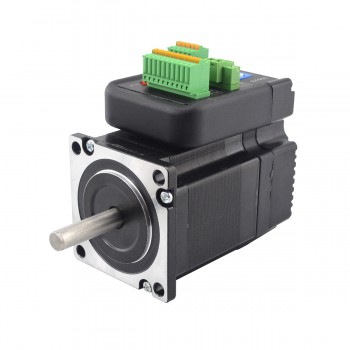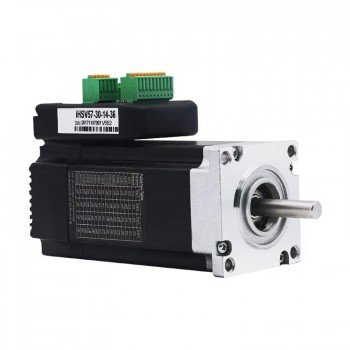1.What is a integrated servo motor?
An integrated servo motor is a compact, single unit that combines a servo motor, feedback device, and servo drive (electronics) into one housing. This all-in-one design eliminates the need for separate components and complex external wiring, simplifying installation and reducing space requirements in automated systems. Integrated servo motors offer high precision, efficiency, and are widely used in robotics, CNC machinery, and other automation applications due to their simplified integration and “plug-and-play” functionality.

2.Working principle of integarted servo motor
An integrated servo motor works on a closed-loop control principle, combining a motor, encoder, and drive into a single unit for high-precision motion. A higher-level controller sends motion commands, which the integrated unit’s internal controller processes to determine the required motor power. The encoder provides real-time feedback on the motor’s actual position and speed, which the drive uses to compare against the command and continuously adjust the power to the motor windings, correcting any errors and ensuring the motor moves exactly as commanded.
3.The importance of integrated servo motor
1.Simplified Design & Installation: The “all-in-one” design drastically reduces the number of components, cabling, and wiring, which simplifies installation and speeds up commissioning.
2.Space Savings: By integrating multiple components into a single unit, integrated servo motors significantly reduce cabinet space and allow for more compact machine designs.
3.Increased Reliability: Fewer external connections and cables mean fewer potential points of failure, reducing the likelihood of errors and leading to a longer service life.
4.Improved Performance: The synergistic integration of motor and drive allows for faster response times, superior torque density, and enhanced positioning accuracy.
5.Energy Efficiency: These systems are designed for optimal performance, consuming less power and converting more energy into useful work, which translates to lower energy costs.
6.Seamless Communication & Control: Advanced integrated servo motors support standard industrial communication protocols, allowing for smooth integration with other control systems, sensors, and fleet management software.
7.Reduced Maintenance: The reduction in external components and complexity leads to fewer maintenance requirements and less potential for downtime.
8.Broad Application: Their precision, reliability, and versatility make them crucial components in industries requiring high-accuracy motion control, including robotics, CNC machinery, packaging, and medical devices.

4.Methods of using integrated servo motor reasonably
1.Safety and Installation:Always connect the motor’s ground terminals to a robust ground connection to prevent electrical shock and ensure product safety.Install the motor in an industrial environment where it is protected from dust, corrosive gases, conductive objects, and fluids.Always turn off the main power and wait for the system to discharge completely before performing any wiring or inspections.The motor shaft should not bear loads exceeding its specified limits.
2.Setup and ConfigurationConnect the servo drive and motor correctly, ensuring the motor’s U, V, W terminals are not directly connected to an AC power supply. Use the manufacturer-provided PC software to modify parameters like subdivision values, then save and apply the changes by power cycling the unit. Set DIP switches for desired configurations, such as pulse modes (PUL/DIR, CW/CCW) and the pulse filter setting.
3.Control Mode Selection:Integrated servo motors typically offer position, speed, and torque control.Choose the mode that best suits your application; for example, use position mode for high-precision positioning requirements.
4.Tuning and Stability:Use the gain tuning panel to adjust control loop gains, which affects the system’s relative stability.While increasing stiffness can improve performance, be mindful of setting parameters too high, as this can lead to instability, oscillation, or vibration.
5.Power Supply Management:Ensure your power supply is robust enough for the motor’s load; a straining servo can cause the supply voltage to sag, leading to unpredictable behavior.For multiple servos, provide each one with a direct connection to the power supply to avoid affecting other servos if one draws significant current.